Fine Motor Skills Toys: How They Help Build Precision and Coordination in Children
Fine motor skills are essential for the successful development of a child. Unlike gross motor skills toys that use large muscles, these skills involve the use of small muscle groups that control the hand, fingers, and thumb. The ability to perform everyday tasks such as buttoning, typing, and writing depends heavily on these skills. As an enthusiast and advisor in child development, I’ve seen firsthand how the right fine motor skills toys can enhance these capabilities, playing a pivotal role in a child’s growth.
What are Fine Motor Skills?
Fine motor skills refer to the coordination between small muscles, like those in the hands and fingers, in conjunction with the eyes. The development of these skills is crucial for children’s overall growth and autonomy, enabling them to complete tasks ranging from feeding themselves to manipulating small objects.
The Role of Fine Motor Skills Toys in Child Development
Toys designed to enhance fine motor skills are more than just a source of entertainment for children; they are crucial educational tools that facilitate learning and development in several key areas. Here’s a closer look at how these toys can benefit child development:
Enhancing Dexterity and Hand-Eye Coordination
Toys like building blocks, threading beads, and jigsaw puzzles require children to manipulate small objects, often with precision. This manipulation improves their dexterity, hand strength, and coordination between their hands and eyes. For instance, stacking blocks demands balance and precision, while threading beads onto a string enhances focus and the ability to make delicate movements, all of which are fundamental to developing fine motor skills.
Self-Care and Independence
Basic self-care tasks such as buttoning shirts, tying shoelaces, brushing teeth, and using utensils are all driven by fine motor abilities. Proficiency in these skills is a significant step towards independence and self-reliance in children, fostering a sense of achievement and confidence.
Encouraging Problem Solving and Cognitive Skills
Many fine motor skills toys also pose challenges that must be solved through logical thinking. For example, puzzles require recognizing patterns and understanding how pieces fit together, which enhances critical thinking and problem-solving skills. Similarly, toys that require sorting shapes and colors promote cognitive development by requiring children to categorize based on different criteria.
Promoting Patience and Perseverance
Activities that require fine motor skills often demand higher levels of concentration and patience from children. Completing a puzzle or building a complex structure with blocks teaches children to work towards achieving a goal, providing a valuable lesson in persistence and the rewards of hard work.
Supporting Creative and Imaginative Play
Fine motor skills toys often allow for creative expression, which is crucial in early childhood development. Art supplies like crayons, markers, and scissors help children express themselves visually, developing not only their artistic abilities but also their imagination. When children create something tangible through their efforts, it boosts their creative thinking and confidence in their abilities.
Social and Emotional Growth
As children engage in play that requires fine motor skills, they often interact with peers, which enhances their social skills. For instance, a group art project requires sharing, turn-taking, and collaborating, which are essential social skills. Additionally, completing a task like a puzzle can provide a sense of accomplishment and pride, boosting their emotional development and resilience.
Preparing for Academic Tasks
The benefits of playing with fine motor skills toys extend into the classroom. Many educational tasks, from writing and drawing to using computers and STEM learning, rely heavily on the fine motor skills that these toys help develop. Early mastery of these skills can give children a significant advantage in school, making learning processes smoother and more enjoyable.
Types of Fine Motor Skills Toys
Fine motor skills toys come in a variety of forms, each designed to target specific aspects of a child’s development. Here’s a closer look at some key types of toys that are particularly effective at enhancing fine motor skills:
Beads and Strings
This category includes toys like bead sequencing sets or lacing beads, which require children to thread beads onto a string or lace. This activity is excellent for developing hand-eye coordination, precision, and the pincer grasp (using the thumb and index finger to hold an object), which are crucial for writing and handling small objects.
Building Blocks and Construction Toys
Toys such as LEGO, building blocks, and magnetic tiles fall into this category. Building with these toys helps children develop spatial awareness, planning skills, and dexterity. As children manipulate the various shapes and sizes to assemble their creations, they refine their grip and learn to control the pressure they apply with their fingers.
Puzzles
From simple wooden puzzles designed for toddlers to more complex jigsaw puzzles for older children, puzzles are exceptional tools for improving fine motor skills. They require children to manipulate various pieces to fit them together, enhancing spatial reasoning and manual dexterity.
Art Supplies
Crayons, markers, paintbrushes, scissors, and glue sticks are all art materials that foster fine motor skills. Drawing, cutting, and pasting require controlled movements and also encourage creativity. For younger children, gripping these items can also be a way to strengthen the muscles in the hands and fingers.
Sorting and Stacking Toys
Toys that involve sorting shapes or stacking rings, like sorting cubes and stackable nesting cups, require precise movements and problem-solving. These toys help children learn to categorize objects based on size, shape, and color, which also taps into cognitive development.
Play Dough and Clay
Playing with play dough or clay is another excellent way to build fine motor skills. The manipulation of these materials involves squeezing, rolling, flattening, and shaping, which strengthens hand muscles and enhances coordination.
Board Games and Card Games
Games that involve the use of cards, dice, or small pieces can improve fine motor skills as well. Moving pieces around a game board, shuffling cards, and rolling dice require precise finger movements and coordination.
Musical Instruments
Small musical instruments such as ukuleles, flutes, or xylophones are not only fun but also beneficial for fine motor development. They require children to use their fingers in specific, controlled ways to produce music, which enhances coordination and rhythm.
Dress-Up Clothes
Toys that include zippers, buttons, and snaps, like dress-up clothes and dolls, teach children how to manipulate fasteners. This is a practical aspect of fine motor skills that children will use daily in their dressing routines.
Tool Sets and Kitchen Sets
Miniature tools and kitchen utensils are great for open ended play and also promote fine motor development. Using a toy hammer, screwdriver, or stirring with a spoon encourages children to use specific movements that mimic real-life tasks.
Choosing the Right Fine Motor Skills Toys
Selecting the appropriate toys for enhancing fine motor skills involves more than just picking out the most popular or colorful options on the shelf. It requires consideration of the child’s developmental stage, interests, and safety needs. Here’s how to choose the right toys to effectively support the development of fine motor skills:
Consider Developmental Stage
It’s crucial to select toys that match the child’s developmental abilities and challenges. For infants and toddlers, large, easy-to-grip blocks or soft dough can be great for squeezing and manipulating. For preschoolers, more intricate puzzles, threading beads, or construction sets that require assembling might be appropriate. Ensuring the toy is developmentally appropriate will help avoid frustration and encourage a successful learning experience.
Align with Interests
Children are more likely to engage with toys that spark their interest. If a child loves animals, consider puzzles that feature animal themes, or if they enjoy outdoor play, consider gardening sets that require the use of small tools. Toys that align with a child’s interests can keep them engaged longer, which enhances the learning experience.
Safety First
Always check the safety features of toys. This includes non-toxic materials, appropriate size (to avoid choking hazards), and sturdy construction to withstand rough handling. Safety also involves ensuring that the toy is suitable for the child’s age and maturity level to prevent accidents and injuries.
Encourage Variety
A range of toys that promote different types of fine motor skills and sensory experiences can provide a comprehensive developmental benefit. Include a mix of textures, shapes, and functions. For example, combining soft dough with rigid building blocks and detailed coloring activities can cater to different sensory and motor demands.
Look for Educational Value
Choose toys that offer more than just one type of play opportunity. Toys that can be used in multiple ways or that grow with the child as they master new skills provide better value and a broader range of developmental benefits. For instance, a set of modular blocks that can be used to create simple structures or more complex designs can adapt to the child’s growing abilities.
Read Reviews and Recommendations
Before purchasing, it can be beneficial to read reviews and seek recommendations from other parents, educators, or child development experts. Their insights can help determine which toys are most effective and enjoyable, based on real-life experiences.
Prioritize Interaction
While many toys are great for solo play, those that encourage cooperative play can also boost social skills along with fine motor skills. Board games, team-building kits, and role-playing sets are examples of toys that can foster interaction with others.
Closing Thoughts From me
Fine motor skills toys are more than just playthings; they are essential tools that equip children with necessary life skills. By incorporating these toys into regular playtime, we can help children develop the fine motor skills needed for academic success and everyday life.
FAQs
What age is appropriate to start introducing fine motor skills toys? Children can start playing with fine motor skills toys as early as one year old, starting with simple items like large blocks and progressing as they grow.
Are electronic toys effective for developing fine motor skills? While electronic toys can enhance certain skills, traditional toys are generally more effective at developing fine motor skills through physical manipulation and sensory exploration.
How often should children play with fine motor skills toys? Daily play with these toys can provide continuous benefits and should be encouraged as part of a balanced playtime routine.
Can fine motor skills toys help children with developmental delays? Absolutely, these toys can be very beneficial for children with developmental delays, often used in therapy practices to enhance motor skills and cognitive development.
What should I do if my child shows no interest in fine motor skills toys? It’s important to integrate the toys into other enjoyable activities or play alongside the child to increase engagement, showing them different ways to explore and enjoy the toys.




